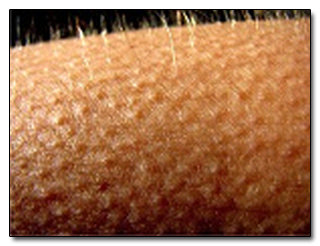The 5 Strangest Things Evolution Left In Your Body

If you don't believe in evolution, you have to spend a lot of time wondering about the useless shit the creator threw into our bodies. Why don't our wisdom teeth fit in our heads? Why do we need an appendix?
The answer is that evolution is a sloppy and haphazard process. Take a close look at your body and you'll see some of the leftover junk. Like...
Goosebumps

There is a little girl standing behind you with dark, sunken eyes and a deadpan expression. She's staring directly at the back of your head, waiting for you to turn around. She wants you to play with her.

FOREVER
Did you feel that slight tingling sensation on the back of your neck? You may have even felt it on your arms and legs too. As you probably know, these are called goosebumps. They tend to mostly occur when we are scared or cold.

But mostly when scared and 11.
They can also appear when we feel sexually aroused or when we feel in awe of something, like listening to a moving piece of music, or if you're the type, watching monster trucks smash smaller cars (to each his own).
But Why?
Ever see the fur on the back of a scared or angry animal suddenly stand straight up?

It's that. Goosebumps are caused by the tiny muscles at the base of your hair follicles contracting, causing our hair to stand on end and covering our skin with tiny bumps.

Like this.
There is really no reason to have this reaction anymore as it's of no use to us. But it was useful to our ancestors who were a lot hairier.
Goosebumps raise the hairs on an animals for two main reasons. First, if the animal is scared, its hair stands on end to appear bigger which might be enough to make a predator change their mind about going after it.

Above: not bear-food.
The second major way goosebumps used to help us out was by keeping us warm when we would have been freezing our asses off. When our ancestors were feeling a little too chilly, their hair would stand on end, trapping a layer of air close to the skin so it could be used as an insulator. It's an ability that most mammals covered in hair still enjoy.

For... um, warmth.
Now that we are lacking in the hair department, we can't use either of these features to our advantage. These days, it's just an easy way to tell if someone's cold, scared or sexually aroused (NOTE: ALWAYS assume the first two).
Flinching When You Hear High-Pitched Sounds

You know the shrill, grating sound of nails scraping slowly across a chalkboard? You probably felt a tingling sensation in your spine just reading that sentence. But in case for some reason you want to refresh your memory on how painful that sound can be, click here.

We warned you.
Why is it that this sound is aversive enough to elicit a physical response? Why does it make us want to tear out our hair and shove pencils in our ears? In a 1986 study, scientists investigated the mystery of irritating sounds. They tested 24 subjects by presenting them with a variety of unpleasant sound recordings and asked them to rate the sounds based on how irritating they were.

"On a scale from one to Ke$ha"
The subjects unsurprisingly rated fingernails on a chalkboard the highest. Also rated as highly irritating were Styrofoam cups rubbing together, a squeaky door hinge and a dentist's drill. All of them in that shrill, high-pitched range.
But Why?
We may never know this one for sure, but researchers noted that the frequency of nails on a chalkboard matches up with the warning cries of a macaque monkey. Since group-warning systems were a powerful defense in our early evolution--that's part of the advantage of living in groups, after all--this could be a leftover from before our warning calls became the more descriptive and sophisticated, "Holy shit, guys, there is a tiger coming." Now that we think of it, listen to the sound a shrieking female victim in a slasher movie makes right before she takes a knife to the eyeball. Tell us that scream doesn't hit something close to that same frequency.
It's also been theorized that those high-pitched sounds may be similar to those made by one of our chief predators from back in those days...

? ...and evolution has just left us with a sensitivity to it (the theory being that everyone who wasn't
A Third Eyelid

Yes, you have a third eyelid. Or the remains of one, anyway. Look at the little pink bit in the corner of your eye, next to your nose.

Head to the nearest mirror and check that shit out, we'll wait.
It's actually called a nictitating membrane, and it's a semi-transparent eyelid that is used by birds, reptiles, amphibians, fish and a handful of mammals. It is at least partially see-through and can be pulled across the eyeball to protect it or moisten it with a weird sideways wink.

"How you doin'?"
But Why?
Sharks use them to protect their eyes from their prey, which no doubt will splash about in terror. Other creatures that live or spend much of their lives in water use them to flush out whatever annoying particles float into their eyeballs. It's useful to birds when they want to feed their young but, at the same time, not get their eyes poked out by their hungry beaks. It's also helpful if you're a peregrine falcon and want to go into a 200 mile-per-hour free fall without little bits of shit in the air flying into your eyeball at that speed.

This is why cars have windshields.
If you want to see one of these eyelids in action first-hand, cats and dogs have a partially functioning nictitating membrane that sometimes shows up when they sleep to cover the eyeball and block out more light.
As for us humans, obviously you can't use whatever is left of your membrane for any of those things. The muscles that control them have degraded to the point where they're practically non-existent. Who knows how far back this vestigial feature could go in our evolution but by the time we started to lose the ability to use it, it was really only good for keeping the gunk out of our eyes. That and staring contests.
Auriculares Muscles (aka the Reason Some People Can Wiggle Their Ears)

Can you wiggle your ears? If you can, you have an ability that about 85 percent of the population doesn't. The muscles that control ear wiggling are the Auriculares muscles that surround the outer ear (the part we can see). Aside from once being able to impress your friends on the schoolyard, they've never been much use to you.
But that wasn't always the case. Thanks our auriculares muscles, our ears were able to do some pretty incredible things once upon a time.

Certain show-offs notwithstanding.
But Why?
Some mammals can move their ears in different directions to pinpoint the locations of sounds. This is especially important to small animals that don't have a great view of their surroundings because they're so close to the ground. They also come in handy when someone's trying to mount your skull above their fireplace.

Millions of years of evolution still won't protect you from a redneck with coffee and a rifle.
Our primate ancestors used to have directional control over their ears too but lost the need for this ability because of our tendency to live in groups. This made the collective vision of the group our main line of defense. Remember what we said earlier about how high-pitched shrieks were probably some kind of vocal alarm to alert the rest of the tribe? Directional hearing would have helped with that sort of thing.
Over time, we've gotten to the point where most of us can't even wiggle our ears, let alone point them at different angles.

We can totally do this, though.
Wisdom Teeth and the Appendix

If you still have your appendix and all of your wisdom teeth in your body, consider yourself lucky. You have a seven percent chance of developing an appendicitis in your lifetime and a whopping 85 percent chance of having at least one impacted wisdom tooth. Both of these things require surgery.
Not only can you live without these features, but you live better without them. All they do is get in the way and/or get infected. They're just pointless extra bullshit.
But Why?
In both cases it appears to be leftover equipment from an era when we used to eat a lot more leaves, before we converted to our modern burrito-based diet.

Although some of us prefer enchiritos.
Your wisdom teeth get impacted and infected because you don't have room for them, and you don't have room for them because they came about when earlier versions of humans had larger jaws, which were more suited to chewing up plant matter. Grinding up leaves as opposed to soft meat and/or pizza is hard work and it requires more teeth to spread out the load. Especially because you have to eat so much of it.

Salad isn't generally considered "filling."
As for the appendix, the most popular theory is that it once helped in digesting all these greens. It's an extension of the cecum, an organ that is much larger in herbivores than carnivores because it's used to break down the tremendous amount cellulose they take in. Since we no longer have a need for this extension of the cecum, it has shrunk into a vestigial organ that looks like a worm. That's just one theory. There actually hasn't been all that much study into the appendix because, you know, who gives a shit what it does.
For more things evolution left us to deal with, check out 6 Insane Dog Behaviors Explained by Evolution and 6 Formerly Kickass Creatures Ruined by Evolution.
And stop by Linkstorm to discover how Internet memes have grown increasingly stupider.
And don't forget to follow us on Facebook and Twitter to get sexy, sexy jokes sent straight to your news feed.
Do you have an idea in mind that would make a great article? Then sign up for our writers workshop! Know way too much about a random topic? Create a topic page and you could be on the front page of Cracked.com tomorrow!